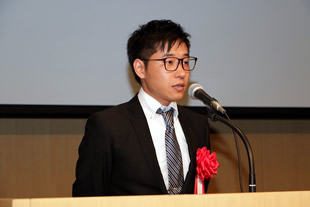 The Winner of the 16th Asia Pacific Research Prize (Iue Prize):
The Winner of the 16th Asia Pacific Research Prize (Iue Prize):
Dr. Hayato Yukawa
Title of Dissertation: “US-Japan Relations in the 1930s: The Role of the Ministry of Foreign Affairs in the Pursuit of New Order in East Asia”

- Dr. Hayato Yukawa
-
- Career -
Hayato Yukawa specializes in the Japanese diplomatic history, and he is currently a Postdoctoral researcher at Kobe University.
March 2013 Completed the master’s program at the Graduate School of Law, Kobe University.
September 2013-June 2014 Visiting researcher at the University of Iowa.
March 2017 Completed the doctoral program at the Graduate School of Law, Kobe University.
- Summary -
After the Manchurian Incident, the Asian school, led by Mamoru Shigemitsu and Hachiro Arita, played the main role at the Ministry of Foreign Affairs. It is said that the school’s diplomatic strategy of abandoning the existing international order and establishing a new East Asian order was one of the factors that aggravated the relationships of Japan with the U.K., the U.S. and some other countries wishing to maintain the status quo. However, this did not immediately mean that diplomatic officials belonging to the Asian school slighted Japan’s relationships with the U.K. and the U.S. As indicated by previous research, diplomatic officials belonging to the Asian school also recognized the importance of Japan’s relationships with the U.K. and the U.S. In other words, during the 1930s, the Ministry of Foreign Affairs needed to simultaneously pursue the two contradictory diplomatic strategies of establishing a new order and maintaining Japan’s relationships with the U.K. and the U.S. How did they try to strike the best balance between the two strategies? This paper strives to find the answer to that question, thereby clarifying the roles played by the Ministry of Foreign Affairs during the 1930s.With this background, this paper presents analyses of the Nine-Power Treaty, which served as the cornerstone of the East Asian order in those days, and the process of negotiations with the U.S. regarding Japan’s policy toward China. The analyses help to reveal what made Shigemitsu and Arita, the key figures of the Asian school, aimed to abandon the international order, how they regarded Japan’s relationship with the U.S. in the process of abandoning the international order and establishing a new order, and how the U.S. recognized it. In addition, this paper also considers and compares the diplomatic strategies of the Asian school, those of Naotake Sato, who belonged to the U.K. and U.S. school, which had become non-mainstream after the Manchurian Incident, and those of diplomatic officials of the reformist school, which served as a third pillar. Such consideration and comparison aid in understanding not only specific individuals and groups but also the entire Ministry of Foreign Affairs during the 1930s.
Consequently, it has been revealed that, against the backdrop of the expansion of the military’s right to speak about politics, the Ministry of Foreign Affairs during this period tried to diplomatically regulate the military’s imprudent strategy of making inroads into China by clarifying the intention of the operation of the Nine-Power Treaty, and to achieve a new East Asian order while maintaining Japan’s relationship with the U.S. It has also been clarified that the Ministry of Foreign Affairs, which engaged in diplomacy in Japan’s sphere of influence, could not resolve the conflict with the idealism of the new diplomacy advocated by the U.S., resulting in the failure of their strategies.






